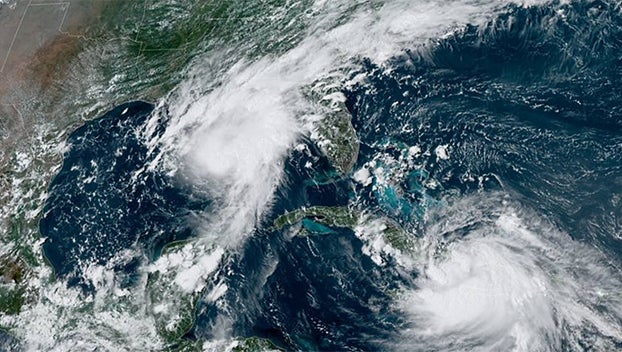Storm updates: Coast residents flee as possible tandem hurricanes threaten area
Published 3:07 pm Sunday, August 23, 2020
|
Getting your Trinity Audio player ready...
|
The Gulf Coast braced Sunday for a potentially devastating hit from twin hurricanes as two strong storms swirled toward the U.S from the Gulf of Mexico and the Caribbean. Officials feared a history-making onslaught of life-threatening winds and flooding along the coast, stretching from Texas to Alabama.
A storm dubbed Marco grew into a hurricane Sunday as it moved up the Gulf of Mexico toward Louisiana. Another potential hurricane, Tropical Storm Laura, lashed the Dominican Republic and Haiti and was targeting the same region of the U.S. coast.
The prospect of piggybacked hurricanes was reviving all-too-fresh memories of damage caused by Hurricane Katrina, which struck the Gulf Coast on Aug. 29, 2005. The storm has been blamed for as many as 1,800 deaths and levee breaches in New Orleans led to catastrophic flooding.
“What we know is there’s going to be storm surge from Marco, we know that that water is not going to recede hardly at all before Laura hits, and so we’ve not seen this before and that’s why people need to be paying particular attention,” Louisiana Gov. John Bel Edwards said at a Sunday briefing.
With the potential the storms could overlap, parts of Louisiana, especially in south-central portions of the state, could see rainfall up to 2 feet, said Benjamin Schott, meteorologist in charge of the National Weather Service’s Slidell, Louisiana, office.
“There has never been anything we’ve seen like this before, where you can have possibly two hurricanes hitting within miles of each over a 48-hour period,” Schott added at a Sunday briefing.
Along the main drag on the barrier island of Grand Isle, south of New Orleans, Starfish Restaurant manager Nicole Fantiny could see an exodus of people driving off the island.
“They are all packing up and leaving,” she said, speaking of the many people who own homes on the island and come out for vacations and weekend trips.
Fantiny lives full-time on the island and wasn’t planning to leave, at least for Marco, but she was anxious about the possible one-two punch of Marco followed quickly by Laura. Her husband works with the town’s fire and police departments, so she said they are always among the last ones to leave.
“My house was built in 1938 so I think we’re good,” she said hopefully.
While Hurricane Marco will likely hit Louisiana first, hurricane experts are more worried about the second potentially stronger smack from Laura.
Marco is expected to dance above and below hurricane status over the next day and a half after hitting the 75 mph-wind mark Sunday afternoon.
“The central Gulf could be really under the gun between Marco and Laura in back-to-back succession,” said Colorado State University hurricane researcher Phil Klotzbach. “Certainly both of these storms can impact New Orleans significantly. It just remains to be seen if the track for Laura tracks a bit to the west.”
University of Miami hurricane researcher Brian McNoldy said, “I would be very worried if I were there” in New Orleans. It’s not so much either storm as much as the long period of storm surge first from Marco and then from Laura and whether the levee system can withstand the stress, he said.
New Orleans resident Matthew Meloy and two friends loaded a van with cases of bottled water in the parking lot of a New Orleans Walmart Sunday. He said they still have a lot of storm prep ahead.
“Check the batteries, flashlights, stocking up on food and trying to park the car on the highest point possible we can find,” he said. “I already spent like 40 minutes this morning filling up the tanks in the cars, just in case, and I’ll be checking the gutters, making sure they’re clear.”
With Marco and its expected landfall in Louisiana Monday evening, the biggest worry is water not wind. Forecasters expect up to 10 or more inches of rain and storm surges of 4 to 6 feet, with 2 to 4 feet around Lake Pontchartrain.
For Laura, add the wind hazard, bigger storm surge and more heavy rain on top of the first rain to increase flooding on already saturated areas, McNoldy said.
Because of strong winds from the southwest, Marco may attain and then lose hurricane status before it hits land sometime Monday, meteorologists said. But those same decapitating winds are likely to be gone a couple days later when Laura ventures to the central Gulf, where the usually bathtub warm water is actually a degree or 2 (0.5 to 1 degree Celsius) warmer than normal, Klotzbach said.
The warmer the water, the stronger the fuel for a hurricane.
“It, unfortunately, might peak in intensity about landfall. That’s the one thing I worry about with this one,” MIT meteorology professor Kerry Emanuel said of Laura. His multiple computer simulations show a decent chance of winds of more than 110 mph for Laura at landfall, as do other computer models.
The key for Laura’s future is how it survives Cuba. The storm is forecast to rake across almost the entire length of the long island and the more it remains over land, the more it can weaken from lack of fuel. But if the storm keeps shifting a bit south, it is more likely to come out strong enough to power up over the favorable environment of the Gulf of Mexico, Klotzbach said.
“Whether it goes south or north makes a big difference,” he said.
The further south, the more likely Laura is to hit further west in the Gulf, possibly into Texas instead of Louisiana, Klotzbach said. If it hits Louisiana that would break the record for two named storms hitting the state so close together. The current record is five days apart in 1885, Klotzbach said.
By Sunday afternoon, Laura was 55 miles (90 km) south of the eastern tip of Cuba with 50 mph (85 kmh) moving west-northwest at 21 mph (33 kmh). Marco was 280 miles (450 km) south-southeast of the mouth of the Mississippi River with 75 mph (120 kph) winds, moving north-northwest at 14 mph (22 kmh).
A few days ago, meteorologists warned of the possibility of two storms in the Gulf at the same time, possibly dancing or interacting with each other, but that’s looking less and likely, Klotzbach said. Marco has sped up and its track has moved further east, while Laura keeps moving further west.
And with Laura there is one long-term possibility that adds to the risk. There’s a chance that as the storm moves north after landfall into Oklahoma, it will be caught up into the jet stream, travel east and emerge over North Carolina and return to tropical storm status, McNoldy and Klotzbach said.






